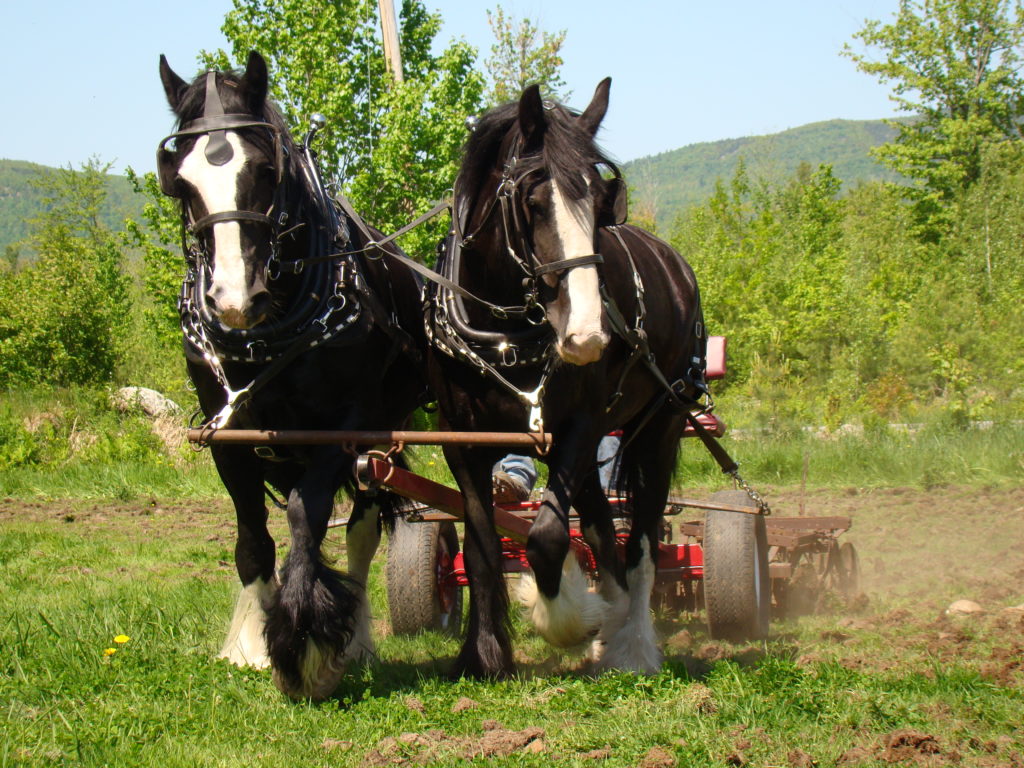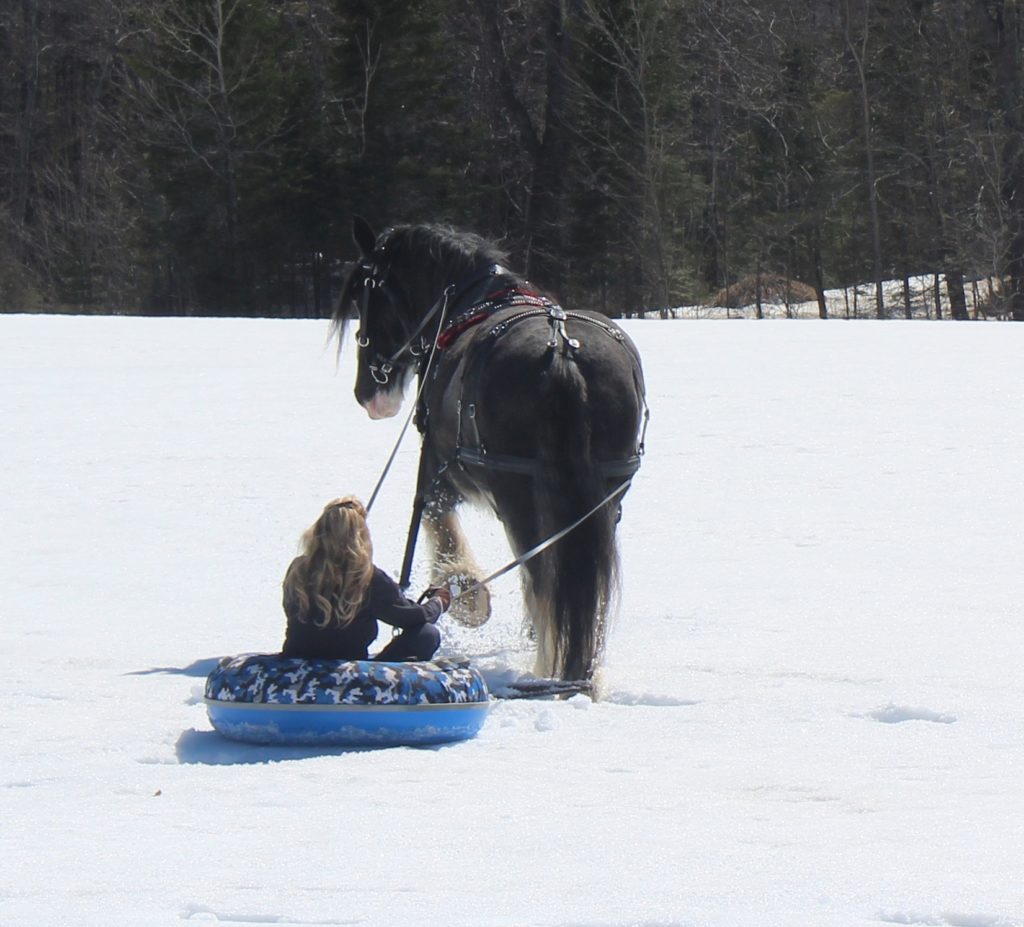How to care for a draft horse
On horse-powered farms and homesteads, draft horses are used for heavy work. But like any animal, these horses need to be treated well. Here’s how to care for a draft horse.

Draft horses are the large equine breeds that farmers used for farmwork for generations until mechanized machines like tractors came along. The horses supplied the power to pull and operate machinery to till, plant and harvest the land.
Today some small-scale farmers and homesteaders are returning to the original “horsepower” using the animals to plow, plant and cultivate fields, practice small-scale selective logging and even as companion animals on the homestead.
Breeds of draft horses
There are many breeds of draft horse, but all share common characteristics of strength and calm temperament, according to Dr. Sallie Hyman, an equine veterinarian at Total Equine Veterinary Associates in Leesburg, Virginia.
The most common draft breeds recognized today include Shires, Belgians, Clydesdales, Percherons, Friesians, Brabants, American Cream Draft, Fjords, Spotted Drafts, Haflingers, Gypsy Vanners, and the Suffolk Punch. Many of these breeds stand 16 to 19 hands — up to 6-feet — tall and can weigh up to 2200 lbs.
It is important to know how to care for a draft horse based on each breeds’ individual needs.
“Draft horses have their share of medical problems,” Hyman said. “Some of which are quite specific to the draft horse or certain breeds of drafts.”
Health issues of draft horses
Among the more common condition affecting draft horses is Equine Polysaccharide Storage Myopathy — or EPSM. According to Hyman, in cases of EPSM draft horses are unable to properly metabolize starches and sugars. These unmetabolized starches and sugars end up being stored in the muscles.
Since the muscles can’t use these abnormal starches and sugars, the muscle fiber will atrophy and become weaker.
Symptoms of EPSM include muscle weakness, intense sweating with exercise, exercise intolerance, reluctance to exercise and an inability to get up after laying down — something known as recumbency. It can hit at any age and there is no cure for EPSM, but Hyman says it can be managed through diet.
“The goal is to significantly reduce sugar and carbohydrates from the diet and replace them with fat,” she said. “Twenty to 25 percent of daily calories should be supplied via fat [and] grass hay should be fed.”
Hyman recommends checking out a complete EPSM diet calculated by her colleague Dr. Beth Valentine at www.ruralheritage.com
Azoturia — also known as “tying up” or “Monday morning disease” — is thought to be an underlying issue associated with EPSM. In this case, elements released through the breakdown of damaged muscles end up in the urine.
While less severe than EPSM, symptoms include muscle pain, cramping, discolored urine and recumbency.
Like EPSM, the major treatment is a modified diet.
Sometimes when working on a draft horse’s hind feet to shoe them or trim the hooves, the horse won’t cooperate. The horse will either refuse to pick up the foot or, once the foot is up, the horse will suddenly and violently use it to kick.
This is not always the sign of a horse being a jerk, Hyman said. More often, it’s a symptom of something called “Shivers.”
Shivers is a neuromuscular disease affecting the hind limbs of draft horses. Symptoms of Shivers include trembling of the horse’s hind end, trembling of its tail when raised and muscle atrophy. A horse with Shivers can be difficult to back up and it may raise its hind leg where it will remain trembling in midair. Conversely, symptoms also include the horse having difficulty in picking up its back feet. In extreme cases the horse’s back legs may begin to violently spasm, making it appear the horse is trying to kick you.
“Too often horses are thought to be misbehaving when they will not easily pick up their hind feet,” Hyman said. “Punishing horses for this will only exacerbate the problem [because] symptoms can worsen if the horse is excited or stressed.”
No one knows what causes shivers, Hyman said, and the only treatment is patience in working with the affected animal.
Chronic Progrssive Lymphedema is a progressive swelling of the lower limbs affecting Clydesdales, Shires and Belgians.
The lower limbs become grossly enlarged with thickened skin folds and nodules that affect mobility, according to Hyman. The average age of the severely affected horse is 15 years.
It’s not known what causes CPL, but Hyman said research has indicated it could be hereditary, so it is important to not breed affected horses.
The disease starts out looking like minor scratches on the horse’s leg, but does not respond to traditional medications. Over time, the skin becomes inflamed and no longer functions properly leading to lymphedema, fibrosis, secondary skin infections and compromised immune systems.
There is no cure for CPL, but keeping the hair on the legs clipped, keeping the legs clean and dry, controlling infections and using compression bandages have been shown to help relieve discomfort, though many horses eventually have to be euthanized.
Caring for a draft horse is a lifestyle
“It’s a lifestyle that some of us want to keep going,” said Vicki Schmidt, draft horse fan and member of the Maine Draft Horse Association. “We just love these animals.”
Any size horse can be useful on a farm or homestead, Schmidt said, but if you are looking to do some heavy pulling work, draft horses are the way to go.
“A saddle or riding horse can easily pull their own weight when it’s in ideal shape,” Schmidt said. “But a draft horse in ideal shape can pull more than two-times its own weight.”
It also comes down to the kind of work that needs to be done on your farm.
“There are times you are actually better off using a tractor for [heavy] work if your land is really rocky or steep,” Schmidt said. “On ground like that a horse could twist an ankle or even break a bone.”
Schmidt likes the best of both worlds on her farm.
“I like to combine technology,” she said with a laugh. “I drive my horses and use a tractor.”
Common draft horse injuries
It take experience working with large horses as a teamster — a person who drives animals — to get the best performance out of the animal and to reduce the risk of injury.
“The more you work with and train your horse, the better you will work together,” Schmidt said. “Plus, these are really nice animals and they will bond with you.”
It’s important to closely observe the animal while working. Hyman said, to make sure all equipment and gear the horse wears for pulling is properly fitted.
Wearing an ill fitting harness or pulling using faulty equipment can cause muscle or tendon damage to the animal.
“It can also cause ‘Sweeney shoulder’ in horses,” Hyman said. “That’s nerve damage in the shoulder that can cause muscle atrophy and loss of strength.”
When in doubt, Schmidt said, check with an experienced teamster to help you properly outfit your draft horse.
Another common injury to draft horses is the train wreck, Hyman said.
“Two horses run head-on into each other, shoulder-to-shoulder [and] that can cause damage to the nerves in the shoulder,” she said.
Hot vs cold
Draft horses have a more difficult time regulating their body temperatures in the warmer summer months, Hyman said.
“They have that huge muscle mass that produces their own heat,” she said. “They tend to tolerate colder temperatures better.”
In summer it’s important draft horses have a shady place to get out of the sun and fans set up in the barn can help cool them off.
“The most important thing is that they have a constant supply of fresh water that is cool in the summer and maybe a bit warm in the winter,” Hyman said.
As for working your draft horse in the summer, it really comes down to common sense.
“If you have eight black [draft horses] let’s not ride them or work them at 3 in the afternoon when it’s 90-degrees and 100 percent humidity,” Hyman said. “There is a rule we follow for all breeds of horses — If you add up the temperature plus the humidity and the total is 120 or less, you are okay to ride or work; at 160 reducel the workload and when it hits 180 or higher, don’t work or ride them at all.”
Feeding your draft horse
Taking care of a draft horse is not as simple as supersizing, Hyman said.
“Draft horses really do have different requirements and it’s not just a matter of their size,” Hyman said. “People think in terms of feeding just because [a draft horse] is bigger they can go to the feed supply store, buy whatever they have and feed based on what the package says is enough for a 2,000-pound horse.”
“Draft horses require a much higher fat component in their diet [and] they should get up to 25 percent of their daily calories from fat,” Hyman said. “That is a much higher level than you are going to find in any feed you buy at a feed store.”

According to Valentine’s article on draft horse nutrition, the minimum daily caloric requirement for a draft horse is 10,000 to 12,000 calories for every 1,000 pounds the horse weights.
A good way to supplement feed or hay to get the needed fat, Valentine says, is to daily add two cups [or one pound] of fat — in the form of high quality vegetable oil — for every 1,000 pounds the horse weighs.
You can gradually introduce the oil or fat into the diet by mixing it with alfalfa pellets. Not only is alfalfa a good source of protein and calcium, horses like the taste and it could help make the fat more palatable to them.
Routine draft horse care
Draft horses should be on the same wellness programs as any horse, including regular vaccinations, worming and regular evaluations for lameness issues.
“With these guys, farrier care is extremely important,” Hyman said. “They have large feet and it’s important to find someone experienced with working with draft horse feet.”
Over the years draft horses have been bred to be strong, obedient and docile, three things that make them great on a farm and as companions, Schmidt said.
“You get really attached to them,” she said. “They want your companionship and they want to please you.”
Hyman finds them much calmer and quieter than saddle horses.
“They are a really docile breed that takes to training well,” she said. “They are really like giant Labrador Retriever [dogs] in that they are very obedient and are like, ‘you taught me this thing, I learned it — I’m a good boy.’”
